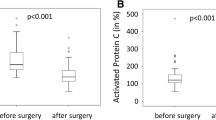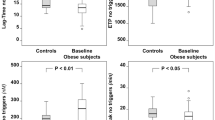Abstract
Hypertension and diabetes are known risk factors for obesity-related thrombosis, but several studies have shown that obesity is characterised by a potentially prothrombotic inflammatory state because of activated coagulation and impaired fibrinolysis. In order to verify if obese patients—unaffected by hypertension, diabetes, dyslipidemia, cigarette smoking or inflammatory diseases—show increased prothrombotic markers and whether the weight loss induced by gastric banding normalises such parameters. Plasma levels of C reactive protein (CRP), fibrinogen, plasminogen activator inhibitor-1 (PAI-1), von Willebrand factor (VWF) and factor VII (FVII) were measured in 25 women with isolated obesity prior to, as well as 3, 6 and 12 months subsequent to gastric banding. Twenty-five healthy women served as a baseline control group. The obese women had higher CRP (p = 0.0001), fibrinogen (p = 0.014), PAI-1 (p = 0.003), VWF (p = 0.004) and FVII levels (p = 0.0001) than the normal controls, and their body mass index (BMI) positively correlated with CRP (r = 0.462, p = 0.02), fibrinogen (r = 0.426, p = 0.04) and PAI-1 (r = 0.468, p = 0.02). Twelve months after gastric banding, the median BMI had decreased from 40.0 to 34.9 (p = 0.0001); CRP from 4.18 to 1.69 μg/ml (p = 0.01); fibrinogen from 389 to 318 mg/dl (p = 0.0001); PAI-1 from 32.1 to 12.0 UI/ml (p = 0.003); VWF from 144 to 120% (p = 0.0001); and FVII from 134 to 112% (p = 0.002). Even in the absence of major cardiovascular risk factors, obese patients are characterised by a prothrombotic state. The weight loss induced by gastric banding decreases the parameters of inflammation, coagulation and impaired fibrinolysis, thus potentially reducing the thrombotic risk.



Similar content being viewed by others
References
Jousilahti P, Tuomilehto J, Vartiainen E, Pekkanen J, Puska P (1996) Body weight, cardiovascular risk factors, and coronary mortality: 15-year follow-up of middle-aged men and women in Eastern Finland. Circulation 93:1372–1379
Van Gaal LF, Mertens IL, De Block CE (2006) Mechanisms linking obesity with cardiovascular disease. Nature 444:875–880
Rosito GA, D’Agostino RB, Massaro J, Lipinska I, Mittleman MA, Sutherland P et al (2004) Association between obesity and a prothrombotic state: the Framingham Offspring Study. Thromb Haemost 91:683–689
Arnlöv J, Ingelsson E, Sundström J, Lind L (2010) Impact of body mass index and the metabolic syndrome on the risk of cardiovascular disease and death in middle-aged men. Circulation 121:230–236
Festa A, D’Agostino R Jr, Howard G, Mykkänen L, Tracy RP, Haffner SM (2000) Chronic subclinical inflammation as part of the insulin resistance syndrome: the Insulin Resistance Atherosclerosis Study (IRAS). Circulation 102:42–47
Esmon CT (2004) The impact of the inflammatory response on coagulation. Thromb Res 114:321–327
Dietrich M, Jialal I (2005) The effect of weight loss on a stable biomarker of inflammation, C-reactive protein. Nutr Rev 63:22–28
Landin K, Stigendal L, Eriksson E, Krotkiewski M, Risberg B, Tengborn L et al (1990) Abdominal obesity is associated with an impaired fibrinolytic activity and elevated plasminogen activator inhibitor-1. Metabolism 39:1044–1048
Trayhurn P, Wood IS (2005) Signalling role of adipose tissue: adipokines and inflammation in obesity. Biochem Soc Trans 33:1078–1081
Guo C, Ricchiuti V, Lian BQ, Yao TM, Coutinho P, Romero JR et al (2008) Mineralocorticoid receptor blockade reverses obesity-related changes in expression of adiponectin, peroxisome proliferator-activated receptor-gamma, and proinflammatory adipokines. Circulation 117:2253–2261
Liuzzo G, Biasucci LM, Gallimore JR, Grillo RL, Rebuzzi AG, Pepys MB et al (1994) The prognostic value of C-reactive protein and serum amyloid a protein in severe unstable angina. N Engl J Med 331:417–424
Boekholdt SM, Kastelein JJ (2010) C-reactive protein and cardiovascular risk: more fuel to the fire. Lancet 375:95–96
Wolk R, Berger P, Lennon RJ, Brilakis ES, Somers VK (2003) Body mass index: a risk factor for unstable angina and myocardial infarction in patients with angiographically confirmed coronary artery disease. Circulation 108:2206–2211
Mathieu P, Lemieux I, Després JP (2010) Obesity, inflammation, and cardiovascular risk. Clin Pharmacol Ther 87:407–416
Selvin E, Paynter NP, Erlinger TP (2007) The effect of weight loss on C-reactive protein: a systematic review. Arch Intern Med 167:31–33
Belachew M, Legrand M, Vincent V, Deffechereux T, JourdanJL MonamiB et al (1995) Laparoscopic placement of adjustable silicone gastric band in the treatment of morbid obesity: how to do it. Obes Surg 5:66–70
De Maria EJ (2007) Bariatric surgery for morbid obesity. N Engl J Med 356:2176–2183
Cobourn C, Mumford D, Chapman MA, Wells L (2010) Laparoscopic gastric banding is safe in outpatient surgical centers. ObesSurg 20:415–422
Mannucci PM, Coppola R. (1999) von Willebrand factor. In: Jespersen J, Bertina RM, Haverkate F (eds) Laboratory techniques in thrombosis. A Manual. Kluwer Academic Publishers, Boston, pp 115–119
Kannel WB, McGee DL (1979) Diabetes and cardiovascular disease. The Framingham study. JAMA 241:2035–2038
Primrose JN, Davies JA, Prentice CR (1992) Reduction in factor VII, fibrinogen and plasminogen activator inhibitor-1 activity after surgical treatment of morbid obesity. Thromb Hemost 68:396–399
Licata G, Scaglione R, Avellone G, Ganguzza A, Corrao S, Arnone S et al (1995) Hemostatic function in young subjects with central obesity: relationship with left ventricular function. Metabolism 44:1417–1421
Rillaerts E, Vansant G, Van Gaal L, DeLeeuw I (1989) Effect of weight reduction on blood viscosity parameters in obese women. Clin Hemorheol l9:983–987
Vague P, Juhan-Vague I, Aillaud MF, Badier C, Viard R, Alessi MC et al (1986) Correlation between fibrinolytic activity, plasminogen activator inhibitor level, plasma insulin level, and relative body weight in normal and obese subjects. Metabolism 35:250–253
Hamsten A, Walldius G, Szamosi A, Blombäck M, de Faire U, Dahlén G et al (1987) Plasminogen activator inhibitor in plasma: risk factor for recurrent myocardial infarction. Lancet 2:3–8
Jansson JH, Olofsson BO, Nilsoon TK (1993) Predictive value of tissue plasminogen activator mass concentration on long-term mortality in patients with coronary artery disease. A 7-year follow-up. Circulation 88:2030–2034
Bouchard L, Vohl MC, Lebel S, Hould FS, Marceau P, Bergeron J et al (2010) Contribution of genetic and metabolic syndrome to omental adipose tissue PAI-1 Gene mRNA and plasma levels in obesity. Obes Surg 20:492–499
Conlan MG, Folsom AR, Finch A, Davis CE, Sorlie P, Marcucci G et al. (1993) Associations of factor VIII and von Willebrand factor with age, race, sex, and risk factors for atherosclerosis. The Atherosclerosis Risk in Communities (ARIC) Study. Thromb Haemost 70:380–38
De Pergola G, De Mitrio V, Giorgino F, Sciaraffia M, Minenna A, Di Bari L et al (1997) Increase in both prothrombotic and anti-thrombotic factors in obese premenopausal women: relationship with body fat distribution. Int J Obes 21:527–535
Blann AD, Bushell D, Davies A, Faragher EB, Miller JP, McCollum CN (1993) von Willebrand factor, the endothelium and obesity. Int J Obes 17:723–725
Folsom AR, Qamhieh HT, Wing RR, Jeffery RW, Strinson VL, Kuller LH et al (1993) Impact of weight loss on plasminogen activator inhibitor (PAI1), factor VII, and other hemostatic factors in moderately overweight adults. Atherioscler Thromb 13:162–169
Faber DR, de Groot PG, Visseren FL (2009) Role of adipose tissue in haemostasis, coagulation and fibrinolysis. Obes Rev 10:554–563
Levi M, van der Poll T, Büller HR (2004) Bidirectional relation between inflammation and coagulation. Circulation 109:2698–2704
Targher G, Zoppini G, Moghetti P, Day CP (2010) Disorders of coagulation and hemostasis in abdominal obesity: emerging role of fatty liver. Semin Thromb Hemost 36:41–48
Svendsen OL, Hassager C, Christiansen C, Nielsen JD, Winther K (1996) Plasminogen activator inhibitor-1, tissue-type plasminogen activator, and fibrinogen. Effect of dieting with or without exercise in overweight postmenopausal women. Arterioscerl Thromb Vasc Biol 16:381–385
Mertens I, Van Gaal LF (2002) Obesity, haemostasis and the fibrinolytic system. Obes Rev 3:85–101
Acknowledgments
This study was supported by “FondoInterno per la RicercaScientifica e Tecnologica” University of Milan.
Conflict of interest
None.
Author information
Authors and Affiliations
Corresponding author
Rights and permissions
About this article
Cite this article
Cugno, M., Castelli, R., Mari, D. et al. Inflammatory and prothrombotic parameters in normotensive non-diabetic obese women: effect of weight loss obtained by gastric banding. Intern Emerg Med 7, 237–242 (2012). https://doi.org/10.1007/s11739-011-0522-x
Received:
Accepted:
Published:
Issue Date:
DOI: https://doi.org/10.1007/s11739-011-0522-x




